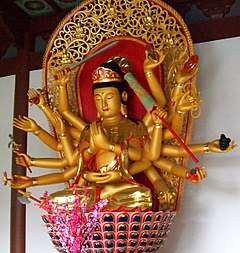Cundi (Buddhism)
Cundī (Wylie: skul byed ma , Chinese: 準提菩薩) is a bodhisattva and an incarnation of the Cundī Dhāraṇī.
| Cundī | |
|---|---|
 | |
| Sanskrit | Cundī |
| Chinese | 準提菩薩 准提菩萨 (Zhǔntí Púsà) |
| Japanese | (romaji: Jundei Kannon) |
| Korean | 준제보살 (RR: Junje Bosal) |
| Thai | พระจุนทีโพธิสัตว์ |
| Tibetan | སྐུལ་བྱེད་མ Wylie: skul byed ma |
| Vietnamese | Chuẩn Đề Bồ tát Phật Mẫu Chuẩn Đề |
| Information | |
| Venerated by | Mahayana, Vajrayana |
| |||||
Cundī appears with eighteen arms on a lotus flower and is sometimes referred to as the "Goddess of the Seventy Million [Buddhas]".[1]
In Buddhist traditions
While Cundī is less well known in Tibetan Buddhism, she is revered in Tángmì or East Asian esoteric Buddhism. In China, she is known as Zhǔntí Púsà (Chinese: 準提菩薩, "Cundi Bodhisattva") or Zhǔntí Fómǔ (Chinese: 準提佛母, "Cundi Buddha-Mother"), "Junje" in Korean, while in Japan she is known as Jundei Kannon (准胝観音, Cundi Avalokiteśvara).
In late imperial China, early traditions of Tangmi were still thriving in Buddhist communities. Robert Gimello has also observed that in these communities, the esoteric practices of Cundī were extremely popular among both the populace and the elite.[2]
Source texts
The first textual source of Cundī and the Cundī Dhāraṇī is the Kāraṇḍavyūhasūtra, a sūtra centered around the bodhisattva Avalokiteśvara that introduced the popular mantra oṃ maṇipadme hūṃ.[3] This text is first dated to around the late 4th century CE to the early 5th century CE.[4] Cundī and the Cundī Dhāraṇī are also featured in the Cundī Dhāraṇī Sūtra, which was translated three times from Sanskrit into Chinese in the late 7th century and early 8th century by the Indian esoteric masters Divākara (685 CE), Vajrabodhi (723 CE), and Amoghavajra (8th century).[3]
Cundī Dhāraṇī
According to the Cundī Dhāraṇī Sūtra, the dhāraṇī associated with Cundī is the following:[5]
- namaḥ saptānāṃ samyaksaṃbuddha koṭīnāṃ tadyathā
- oṃ cale cule cundī svāhā
In the sūtra, the Buddha speaks extensively about the various effects and benefits of reciting the Cundī dhāraṇī. Many of the effects are purifying and uplifting in nature. For example, after pronouncing the dhāraṇī, the Buddha then says:[5]
If there are bhikṣus, bhikṣuṇīs, upāsakas, or upāsikās who memorize and recite this dhāraṇī 800,000 times, their deadly karma in every place, created over innumerable eons, will be completely annihilated. In every place where they are born or reside, they will always meet Buddhas and bodhisattvas. They will always have adequate resources and abilities to do as they wish. In any birth, they will always be able to leave the home life, and will have the ability to maintain the pure precepts of a bodhisattva. They will be born in human or heavenly realms, they will not fall into evil destinies, and they will always be protected by all the heavenly guardians.
The dhāraṇī is also closely associated with buddhahood and complete enlightenment (Skt. Anuttarā Samyaksaṃbodhi). At the end of the sūtra, the Buddha closes the teaching by saying:[5]
This great dhāraṇī of Cundī is a great brilliant mantra teaching that is spoken by all Buddhas of the past, all Buddhas of the future, and all Buddhas of the present time. I also now speak it thusly to benefit all sentient beings, causing them to attain Anuttarā Samyaksaṃbodhi. If there are sentient beings with little merit, who lack the roots of goodness, natural ability, and the Factors of Bodhi, if they obtain hearing of this dhāraṇī method, they will quickly realize the attainment of Anuttarā Samyaksaṃbodhi. If there are people who are always able to remember, recite, and maintain this dhāraṇī, they will all obtain immeasurable roots of goodness.
Iconography
Cundī is depicted with eighteen arms, each wielding implements that symbolize upaya. Her eighteen arms also represent the eighteen merits of attaining Buddhahood as described in an appendix to the Cundī Dhāraṇī Sūtra.
See also
References
| Wikisource has original text related to this article: |
- Buswell, Robert E.; Lopez, Donald S. (eds.). The Princeton Dictionary of Buddhism. NJ: Princeton University Press. p. 204. ISBN 978-0-691-15786-3.
- Gimello, Robert (2004). ″Icon and Incantation: The Goddess Zhunti and the Role of Images in the Occult Buddhism of China." In Images in Asian Religions: Texts and Contexts ed. Phyllis Granoff and Koichi Shinohara: pp. 71-85.
- Studholme, Alexander (2002) The origins of Oṃ maṇipadme hūṃ: a study of the Kāraṇḍavyūha sūtra: p. 175
- Studholme, Alexander (2002) The origins of Oṃ maṇipadme hūṃ: a study of the Kāraṇḍavyūha sūtra: p. 17
- The Cundī Dhāraṇī Sūtra

